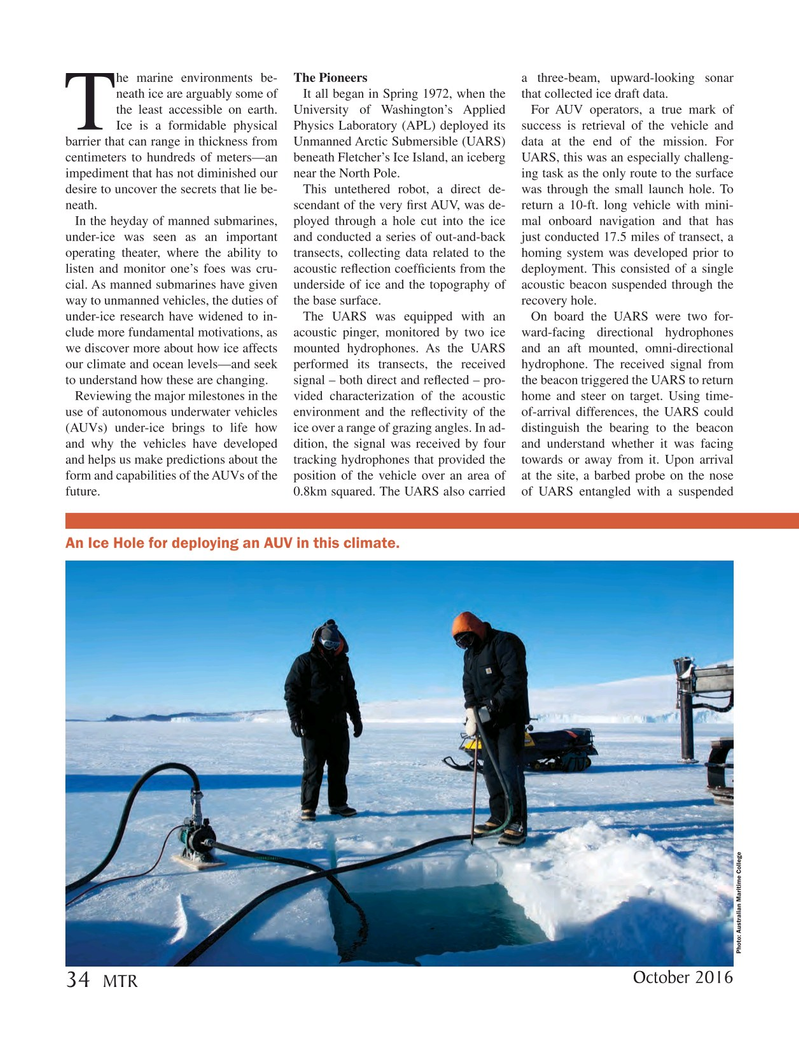
Page 34: of Marine Technology Magazine (October 2016)
AUV Operations
Read this page in Pdf, Flash or Html5 edition of October 2016 Marine Technology Magazine
he marine environments be- The Pioneers a three-beam, upward-looking sonar neath ice are arguably some of It all began in Spring 1972, when the that collected ice draft data.
the least accessible on earth. University of Washington’s Applied For AUV operators, a true mark of
TIce is a formidable physical Physics Laboratory (APL) deployed its success is retrieval of the vehicle and barrier that can range in thickness from Unmanned Arctic Submersible (UARS) data at the end of the mission. For centimeters to hundreds of meters—an beneath Fletcher’s Ice Island, an iceberg UARS, this was an especially challeng- impediment that has not diminished our near the North Pole. ing task as the only route to the surface desire to uncover the secrets that lie be- This untethered robot, a direct de- was through the small launch hole. To neath. scendant of the very ? rst AUV, was de- return a 10-ft. long vehicle with mini-
In the heyday of manned submarines, ployed through a hole cut into the ice mal onboard navigation and that has under-ice was seen as an important and conducted a series of out-and-back just conducted 17.5 miles of transect, a operating theater, where the ability to transects, collecting data related to the homing system was developed prior to listen and monitor one’s foes was cru- acoustic re? ection coef? cients from the deployment. This consisted of a single cial. As manned submarines have given underside of ice and the topography of acoustic beacon suspended through the way to unmanned vehicles, the duties of the base surface. recovery hole. under-ice research have widened to in- The UARS was equipped with an On board the UARS were two for- clude more fundamental motivations, as acoustic pinger, monitored by two ice ward-facing directional hydrophones we discover more about how ice affects mounted hydrophones. As the UARS and an aft mounted, omni-directional our climate and ocean levels—and seek performed its transects, the received hydrophone. The received signal from to understand how these are changing. signal – both direct and re? ected – pro- the beacon triggered the UARS to return
Reviewing the major milestones in the vided characterization of the acoustic home and steer on target. Using time- use of autonomous underwater vehicles environment and the re? ectivity of the of-arrival differences, the UARS could (AUVs) under-ice brings to life how ice over a range of grazing angles. In ad- distinguish the bearing to the beacon and why the vehicles have developed dition, the signal was received by four and understand whether it was facing and helps us make predictions about the tracking hydrophones that provided the towards or away from it. Upon arrival form and capabilities of the AUVs of the position of the vehicle over an area of at the site, a barbed probe on the nose future. 0.8km squared. The UARS also carried of UARS entangled with a suspended
An Ice Hole for deploying an AUV in this climate.
Photo: Australian Maritime College
October 2016 34
MTR
MTR #8 (34-49).indd 34 9/27/2016 2:42:49 PM

 33
33

 35
35
